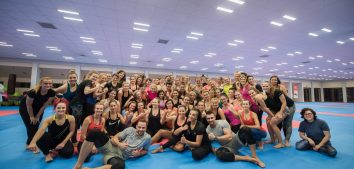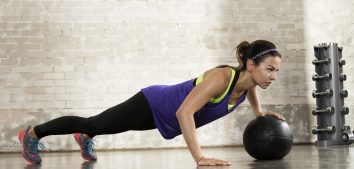
Methods and Types of Sport Training
As you probably know, there are quite a few types of training. You often ask what type of training you should choose: strength training, endurance training, or maybe peripheral training? You also ask whether training can help you reduce adipose tissue and shape your body without excessive muscle development. Therefore, in this post I will help you organize all the most important issues. I hope you can find the answers to all these questions. Enjoy 🙂
Why is training worth the effort?
Taking up regular physical activity has many benefits for men and women, both for their physical and mental health. Properly chosen training increases fitness and physical efficiency and is a prevention of many diseases which helps to maintain better health and well-being. According to the World Health Organization (WHO), the minimum dose of moderate-intensity physical activity should last about 30 minutes 5 times a week, while high intensity workout (including strength and endurance training) should amount to 20 minutes 3 times a week.
What are the goals and types of training?
When you begin, it is worth knowing what goal you want to achieve and then think about the methods that will help you succeed. For some people, the goal will be to lose extra kilos or improve their shape, for others to stay healthy and fit, and for the rest of the group it will be a way to relieve everyday stress. Regardless of what your goal is, it is important that you stay motivated and remember that everything is in your hands and… in your head ?
The main training goals:
- weight loss,
- fatty tissue reduction,
- building muscle mass,
- strengthening and increasing the body’s efficiency,
- relaxation and stress reduction.
Each physical activity or training should be adapted to your age, health and general physical fitness because different exercises will be suitable for a beginner who has just started the adventure with training, and different ones for an advanced person who exercises daily. Training should always be preceded by a warm-up. It is also important to start your exercises slowly and gradually increase their intensity to prevent rapid fatigue, injuries and discouragement.
Types of training:
- strength (resistance),
- endurance,
- circuit (strength + endurance),
- functional,
- relaxation.

Strength training
Strength training is one of the most common types of exercise in the gym because it helps build and strengthen your muscles. Resistance exercises increase muscle strength by forcing them to work more than usual. In addition, it increases the body’s metabolism, which allows you to effectively reduce body fat. The result will be a slim and aesthetic silhouette with outlined muscles. Strength exercises include, lifting weights, training on machines or training with the weight of your own body.
Types of strength training:
- Full Body Workout (FBW) – in which you exercise your whole body.
- Split – in which particular parts of the body are exercised in a specific training unit.
The advantages of strength training:
- increasing muscle mass and strength,
- toning muscles and making them more visible,
- reduction of adipose tissue,
- improving the appearance of the body and posture,
- strengthening of the body mechanics,
- the ability to work on specific parts of the body.
The disadvantages of strength training:
- it often requires the use of equipment, e.g. dumbbells or barbells,
- the effects require regularity and time, as well as an appropriate diet,
- when the workouts are not planned well, there may be an uneven development of muscle mass: strength and muscle asymmetry,
- risk of injury (joint strain and degeneration) and pain.
Endurance training
Endurance training, commonly known as cardio, aims to strengthen the entire body by affecting the cardiovascular and respiratory systems. These exercises improve blood circulation, increase the respiratory capacity of the lungs and strengthen the walls of the heart muscle, thereby improving the overall efficiency of the body. In addition, they increase metabolism, and if regularly performed, they help reduce body fat and shape the body. The most popular endurance exercises include: running, cycling, swimming, stepper exercises and skipping rope.
Types of endurance training:
- constant intensity,
- different intensity – interval. HIIT (High-Intensity Interval Training) – interval training in which you perform exercises with different intensity. Short periods of increased effort alternate with longer recovery periods (of medium intensity). The result is an improvement in fitness and reduction of body fat.
The advantages of endurance training:
- strengthens and increases the body’s efficiency,
- burns fat,
- improves the shape of your body,
- yields quick results,
- regular training reduces the risk of diseases such as obesity, diabetes, hypertension.
The disadvantages of endurance training:
- long training time,
- intense or improperly selected training can burden the joints, especially in overweight or obese people.
Circuit training
Circuit training combines the features of strength and endurance training, thanks to which it helps to burn fat, shape the body and improve the condition of the body. Because weight is not so important here, it does not lead to significant muscle growth. Circuit training consists in a few to a dozen or so exercises that are performed without interruption, moving directly from one exercise to another. Breaks are made only after the entire circuit is complete.
The advantages of circuit training:
- reduction of adipose tissue,
- improvement in the condition of the body,
- improvement in the appearance of the body,
- does not lead to significant muscle growth.
The disadvantages of circuit training
- does not lead to significant muscle growth,
- risk of injury.
Functional training
Functional training is about performing simple exercises to strengthen the muscles without over-expanding them. In addition, these exercises improve the locomotor system, improve muscle balance and stabilize joints, thus correcting posture defects. During exercise, attention is paid to movements that are performed daily with normal activities, but at a faster pace and with many repetitions. Equipment such as dumbbells, a medicine ball, tapes or bands is usually necessary. The functional exercises include e.g. climbing stairs with dumbbells, squats with dumbbells or torso twists with a medicine ball.
The advantages of functional training:
- preventing injuries by improving the locomotor system, increasing mobility and range of motion,
- strengthening the muscles without their excessive development.
The disadvantages of functional training:
- does not lead to significant muscle growth
Relaxation training
Relaxation training, as the name suggests, is designed to relax the body and mind, and at the same time improve the well-being after a stressful day or calm the body after intense exercise, by relaxing muscles and joints. This training will also be good for anyone who wants to stretch or has various types of pain, e.g. spine, because it increases the range of motion and corrects body posture. Relaxation training includes: stretching, yoga or pilates.
The advantages of relaxation training:
- helps to relax and relieve stress,
- a good way to end a more intense training,
- low risk of injury,
- it is suitable for all people,
- helpful in muscle pain or maintaining proper body posture.
The disadvantages of relaxation training:
- has a slight effect on the reduction of body fat

Male vs female training
Both women and men can train in exactly the same way, there are no recommendations or rules that some type of training cannot be used by either gender. However, you may notice some gender differences in the desired types of training. Women often have different goals than men. Most often they want to achieve a slim, firm, and toned body. However, they try to avoid excessive muscle development. On the other hand, men want to build up their muscles, especially in the upper part.
The purpose of the exercises determines the type of training, as well as its intensity and frequency. Women usually choose cardio or circuit training, while men choose strength training. This does not mean, however, that women cannot do strength training. They can and even should. Strength training will be dominated by different exercises in men and in women. Women usually perform exercises to slim down the stomach, legs and buttocks. In turn, men will focus on exercises involving the muscles of the chest, arms and back.
When it comes to the intensity and frequency of exercise, it is recommended for women to have less intense workouts but with more repetitions. Such training will also avoid excessive muscle development. On the other hand, because men have more testosterone, they respond better to strength training, thanks to which they will build mass and strength faster. For best results, it is recommended to exercise at high intensity, but with fewer repetitions. Training intensity in strength exercises is the type of load you use during the workout, while training volume is the total number of series and repetitions you perform during a given training session.
Is training at home effective?
The answer is: YES! Training at home is suitable for everyone, and especially for all those who always have a million excuses such as: lack of time, money, bad weather or for people who simply don’t like gyms or fitness clubs, or are ashamed and want to avoid the eyes of other people. In addition, when exercising at home, you can do any type of training, from cardio training, energetic tabata, strength exercises using your own body weight, to relaxing stretching. However, with small equipment at your disposal, such as dumbbells (you can also use water bottles), mini bands or a chair, you can perform many exercises involving every part of the body. Remember that you find many types of training, both with and without small equipment, in the app Diet & Training by Ann.
In conclusion, physical activity is a very important part of a healthy lifestyle. When you take up a given type of training, try to choose one that gives you pleasure, not one that is an unpleasant necessity. There is no point in jogging if you don’t like running and would prefer to do cardio instead. Such training will not be beneficial, but will only lead to unnecessary frustration and aversion to physical activity. Instead of running, choose something that will give you more satisfaction, such as cycling or swimming. When you approach your training with enthusiasm and a smile on your face, you will achieve results faster than you expect ?
Bibliography:
- Andersen J.L., Aagaard P. Effects of strength training on muscle fiber types and size; consequences for athletes training for high-intensity sport. Scand J Med Sci Sports. 2010; 20 (Suppl. 2): 32–38.
- Neves L. M., Fortaleza A. C., Rossi F. E., Diniz T. A. et al. Functional training reduces body fat and improves functional fitness and cholesterol levels in postmenopausal women: a randomized clinical trial. The Journal of Sports Medicine and Physical Fitness 2017; 57(4):448-56.
- Nystoriak M.A., Bhatnagar A. Cardiovascular Effects and Benefits of Exercise. Front Cardiovasc Med. 2018; 5:135.
- Suchomel T. J., Nimphius S., Bellon C. R., Stone M. H. The Importance of Muscular Strength: Training Considerations. Sports Med. 2018.
- Terrence R. M., Matthew G. S., Matthew S. S., TOM J. H. Whole-Body Aerobic Resistance Training Circuit Improves Aerobic Fitness and Muscle Strength in Sedentary Young Females. Journal of Strength and Conditioning Research. 2015; 29(6)/1592–1600.
- Wilson J. M., Loenneke J. M., Jo E., Wilson G. J., ILSON, Zourdos M. C., Kim J-S. The effects of endurance, strength, and power training on muscle fiber type shifting. Journal of Strength and Conditioning Research. 2012; 26(6)/1724–1729.










Comments No Comments
Join the discussion…